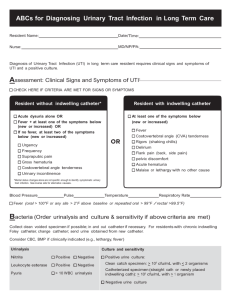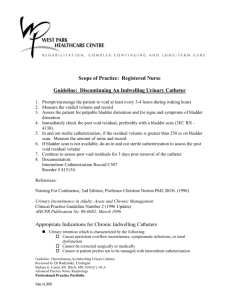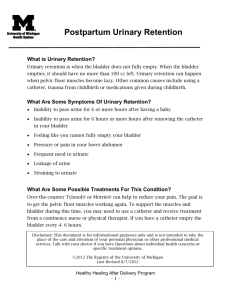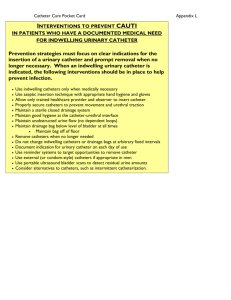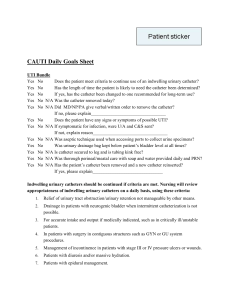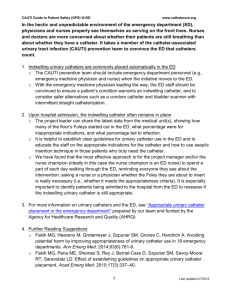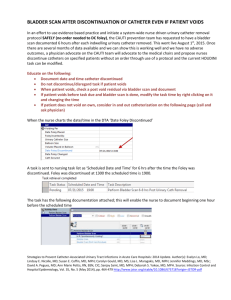CAUTI Prevention in Long-Term Care
advertisement
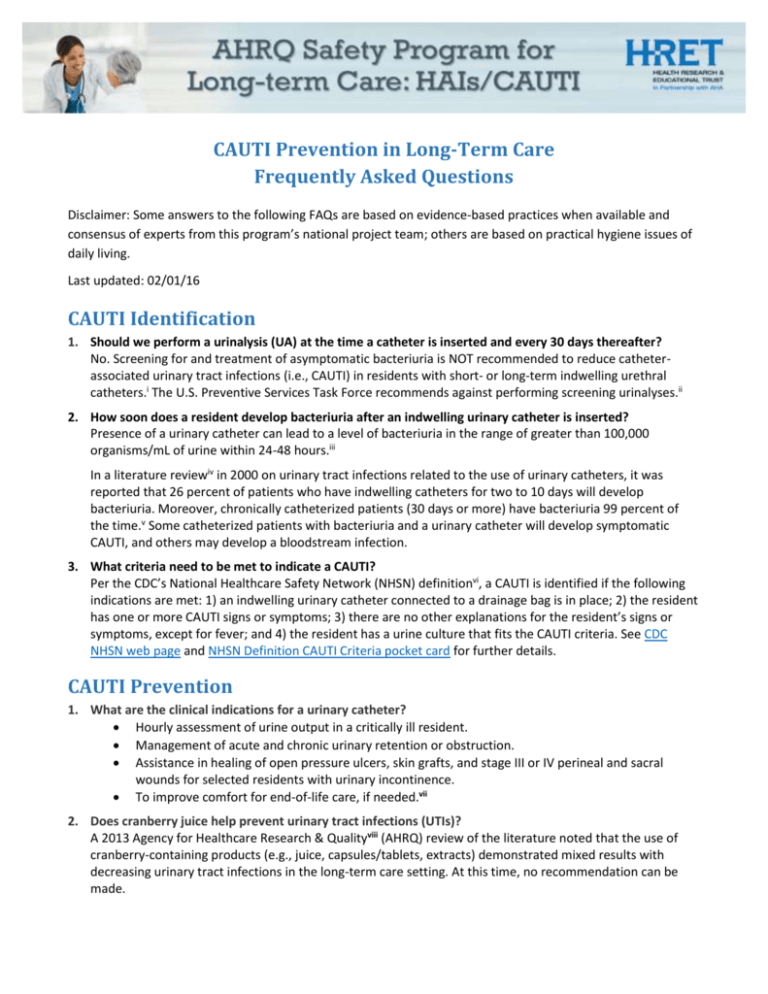
CAUTI Prevention in Long-Term Care Frequently Asked Questions Disclaimer: Some answers to the following FAQs are based on evidence-based practices when available and consensus of experts from this program’s national project team; others are based on practical hygiene issues of daily living. Last updated: 02/01/16 CAUTI Identification 1. Should we perform a urinalysis (UA) at the time a catheter is inserted and every 30 days thereafter? No. Screening for and treatment of asymptomatic bacteriuria is NOT recommended to reduce catheterassociated urinary tract infections (i.e., CAUTI) in residents with short- or long-term indwelling urethral catheters.i The U.S. Preventive Services Task Force recommends against performing screening urinalyses.ii 2. How soon does a resident develop bacteriuria after an indwelling urinary catheter is inserted? Presence of a urinary catheter can lead to a level of bacteriuria in the range of greater than 100,000 organisms/mL of urine within 24-48 hours.iii In a literature reviewiv in 2000 on urinary tract infections related to the use of urinary catheters, it was reported that 26 percent of patients who have indwelling catheters for two to 10 days will develop bacteriuria. Moreover, chronically catheterized patients (30 days or more) have bacteriuria 99 percent of the time.v Some catheterized patients with bacteriuria and a urinary catheter will develop symptomatic CAUTI, and others may develop a bloodstream infection. 3. What criteria need to be met to indicate a CAUTI? Per the CDC’s National Healthcare Safety Network (NHSN) definitionvi, a CAUTI is identified if the following indications are met: 1) an indwelling urinary catheter connected to a drainage bag is in place; 2) the resident has one or more CAUTI signs or symptoms; 3) there are no other explanations for the resident’s signs or symptoms, except for fever; and 4) the resident has a urine culture that fits the CAUTI criteria. See CDC NHSN web page and NHSN Definition CAUTI Criteria pocket card for further details. CAUTI Prevention 1. What are the clinical indications for a urinary catheter? Hourly assessment of urine output in a critically ill resident. Management of acute and chronic urinary retention or obstruction. Assistance in healing of open pressure ulcers, skin grafts, and stage III or IV perineal and sacral wounds for selected residents with urinary incontinence. To improve comfort for end-of-life care, if needed.vii 2. Does cranberry juice help prevent urinary tract infections (UTIs)? A 2013 Agency for Healthcare Research & Qualityviii (AHRQ) review of the literature noted that the use of cranberry-containing products (e.g., juice, capsules/tablets, extracts) demonstrated mixed results with decreasing urinary tract infections in the long-term care setting. At this time, no recommendation can be made. 3. Should methenamine be used to prevent catheter-associated UTIs? No. Evidence does not support use of methenamine hippurate (also called methanamine mandelate) to prevent UTI in persons with neurogenic bladders.ix 4. Does irrigation help prevent UTIs? Catheter irrigation with normal saline should not be used routinely to reduce catheter-associated bacteriuria, CAUTI or obstruction in residents with long-term indwelling urinary catheterization, per IDSA CAUTI guidelines. Moreover, the Centers for Disease Control and Prevention (CDC, 2009)x does not recommend routine bladder irrigation unless obstruction is anticipated (e.g., after bladder or prostatic surgery). 5. Are there specific prevention strategies for a resident with a neurogenic bladder? No.xi Infection prevention strategies apply to all residents, regardless of their medical condition or indication for having a urinary catheter. Hand Hygiene 1. Are alcohol-based hand rubs superior to soap and water?i.xii Yes, if hands are not visibly soiled, use an alcohol-based hand rub for routinely decontaminating hands in clinical situations, such as: Before and after having direct contact with residents Before handling medication Before and after handling indwelling urinary catheters or other invasive devices that do not require a surgical procedure After having contact with a resident’s intact skin (e.g., when taking a pulse or blood pressure, lifting a resident) After having contact with body fluids or excretions, mucous membranes, non-intact skin and wound dressings if hands are not visibly soiled If moving from a contaminated body site to a clean body site during resident care After having contact with inanimate objects (including medical equipment) in the immediate vicinity of the resident Before and after wearing gloves When hands are visibly dirty or are visibly soiled with blood or other body fluids, wash hands with soap and water for at least 15 seconds.xiii Any needle stick or similar injury that involves exposure to blood or body fluids should be washed with copious amounts of water and soap and follow the facility’s post-exposure protocol. 2. Is it okay to wash gloves? No. Perform hand hygiene before and after wearing gloves, but do NOT wash or reuse gloves after caring for a resident. Change gloves during resident care if moving from a contaminated body site to a clean body site, or completing a resident task involving potential soiling (e.g., removing a dressing or soiled brief). Remove gloves after caring for the resident. 2 Barrier Precautions 1. Why is it important to use gloves and gowns (when possible) during assistance with intimate (e.g., toileting, bathing) activities of daily living (ADLs)? Research has shown that residents with a urinary catheter have a higher chance of having multi-drug resistant organisms (MDROs) in their groin.xiv.xv By using gowns and gloves during intimate ADLs, such as morning and evening care, staff can avoid contaminating their own hands and clothing due to splashing, therefore minimizing the risk of infecting others with MDROs.xvi.xvii 2. Should a gown be worn for indwelling urinary catheter insertion? Generally, a gown is not routinely worn by those inserting a urinary catheter into a resident. However, it is important that you follow your facility’s policies, which may include an enhanced standard-precautions model or a MDRO policy. For example, a gown would be worn when anticipating or having potential contact with all moist body fluids (e.g., diarrhea) during the catheter insertion. 3. When the resident has an indwelling urinary catheter, should the frontline staff member put on a gown at the beginning of the bath or just when catheter care is given? If a resident has an indwelling urinary catheter, it is recommended that frontline staff put on a gown before beginning the bath. 4. How should a resident with an indwelling urinary catheter be bathed? The general recommendation is to move from the cleaner area to the less clean area. The HICPAC guidelines state to perform hand hygiene immediately before and after insertion or any manipulation of the catheter device or site, and to not clean the periurethral area with antiseptics in order to prevent CAUTI while the catheter is in place. Routine hygiene (e.g., cleansing of the meatal surface during daily bathing or showering) is appropriate.i Review Bath Basin FAQs for more information. 5. What PPE should be worn when bathing a resident? It is recommended that staff use a gown and gloves during routine bathing. There is no evidence that the national project team is aware of that shows the risks or benefits of changing gloves prior to or immediately following catheter care as part of the general bathing process. However, there is no harm in changing gloves, performing hand hygiene and re-gloving before or after catheter care during routine bathing. Catheter Management 1. Why is it important to use the smallest sized catheter for a resident if I need to insert a catheter? This will help to reduce urethral and bladder injury (e.g., irritation, hemorrhage, ulceration), which increases the risk of infection. 2. What should I do if a resident wants a catheter due to dignity issues but there are no appropriate indications for a catheter? This request is rare. The Centers for Medicare and Medicaid Servicesxviii requires a valid clinical rationale and medical justification for an indwelling catheter. See CAUTI Identification, question 3 for clinical indications. Due to resident choice, this can become a gray area. Documentation and the care plan should reflect education (e.g., infection risk, skin care issues, potential mortality with a urinary catheter due to sepsis) and attempts to prevent catheterization (e.g., toileting program, trials with different incontinence briefs). The physician may be reluctant to give the catheter insertion order. There may be value in consulting with the state surveying agency for additional guidance. 3 3. Should we change urinary catheters every 30 days? No, there is little evidence to suggest any benefit that routine catheter- or drainage-bag changes prevent CAUTI.x 4. Are there any recommendations on when a chronic indwelling urinary catheter should be changed for a resident in the long-term care setting? HICPAC/CDC CAUTI Prevention Guidelines states, “Changing indwelling catheters or drainage bags at routine, fixed intervals is not recommended. Rather, it is suggested to change catheters and drainage bags based on clinical indications, such as infection, obstruction, or when the closed system is compromised.”xix The Infectious Diseases Society of America (IDSA) in their Guidelines on Diagnosis, Prevention and Treatment of CAUTI does include the following recommendation for a patient with an indwelling urinary catheter in whom symptomatic CAUTI is suspected: “45. A urine specimen for culture should be obtained prior to initiating antimicrobial therapy for presumed CA-UTI because of the wide spectrum of potential infecting organisms and the increased likelihood of antimicrobial resistance…. 46. If an indwelling catheter has been in place for 2 weeks at the onset of CA-UTI and is still indicated, the catheter should be replaced to hasten resolution of symptoms and to reduce the risk of subsequent CA-bacteriuria and CA-UTI. i. The urine culture should be obtained from the freshly placed catheter prior to the initiation of antimicrobial therapy to help guide treatment. ii. If use of the catheter can be discontinued, a culture of a voided midstream urine specimen should be obtained prior to the initiation of antimicrobial therapy to help guide treatment…"i 5. What products do you recommend for catheter care? The national project team cannot recommend nor endorse any product, medication or treatment. Review evidence-based practices and recommendations to develop policies and procedures for catheter care in your LTC facility. This should include not cleaning the periurethral area with antiseptics to prevent CAUTI while the catheter is in place. Routine hygiene (e.g., cleansing of the meatal surface during daily bathing or showering) is appropriate. Alternatives to Indwelling Urinary Catheterization 1. For residents who are catheterized long-term, would switching to a suprapubic catheter be appropriate? A suprapubic catheter is used when a urethral catheter is contraindicated or fails to function appropriately. However, there is no evidence that suprapubic catheters reduce the risk of bacteriuria in the urine.xx Examples when a suprapubic catheter is used include: Urethral injuries or trauma Urethral obstruction Bladder neck masses Benign prosthetic hypertrophy (BPH) Prostate cancer Desire to resume sexual activity Potential ease of management (e.g., care around the insertion site) Situations where self-urinary catheterization is not an option Potential contraindications include: Coagulopathy, until corrected 4 Prior lower abdominal or pelvic surgery, due to the potential of bowel adherence to the bladder or abdominal wall Pelvic cancer, due to the increased adhesion risk Bowel perforation and intra-abdominal injuries are possible during the insertion. The advantages and disadvantages (i.e., spasm, catheter blockages, insertion site discharge) of the procedure should be fully explored and understood prior to undertaking the procedure. 2. What are the recommendations for caring for a resident with a suprapubic catheter? There are numerous evidence-based resources that address how to physically care for the suprapubic catheter. It’s important to review several resources and develop a facility policy and procedure, citing these references in the policy.xxi In general, suprapubic catheters are changed by urologists. Residents and family members will need education and emotional support when transitioning to a suprapubic catheter. Additionally, caretakers may also need to undergo additional education and staff competencies may need to be developed. 3. What resources are available for bladder training, indwelling urinary catheters and rehabilitation? Bladder training is a process to teach a resident to manage and empty his/her bladder without the need for instrumentation or a device. Some bladders require training to become reflex bladders and others will need training as contractile bladders. All methods of bladder management involve a degree of training and routine. It is important not to allow the bladder to remain empty (e.g., by indwelling catheter on free drainage) as this will reduce its capacity and strength. To maintain or increase bladder strength and capacity, the bladder should be trained to regularly hold a volume of urine. Developing a bladder-management program for rehab residents for example, helps prevent UTIs, bladder over-distention and kidney damage. The type of management program depends on many factors. Some of them include: Level of injury and extent of loss of normal urinary system function Susceptibility to infection, including overall medical and surgical history Can/will the resident adhere to the program? o Ability to sit, stand and ambulate o Lifestyle (i.e., is the resident highly active, etc.?) Availability of clinically effective products/systems The object of bladder training is to maintain the resident's bladder at the appropriate volumes for optimum overall health. Methods of bladder retraining are supplemented by monitoring fluid intake to prevent UTIs and control urine volume and concentration, developing scheduled times for urination and using body positions to facilitate voiding. Successful bladder training is an interdisciplinary function; ideally, the three disciplines of nursing, physical therapy (PT) and occupational therapy (OT) work together. Bladder training often begins when OT and nursing agree that the resident is physically and functionally able to begin. PT generally assesses the ability of the resident to "transfer" him/herself. They also assess if a wheelchair is needed, and if so, what type. OT assesses if other equipment is needed and the resident's actual abilities and disabilities. Nursing provides the follow-through and reinforcement on a daily basis. Nursing is also responsible for overall physical assessment and often coordinates the efforts of other disciplines. All disciplines are expected to document the effectiveness of their efforts (or lack thereof). The ideal plan is to train the resident as well as other providers and family members. Training also includes education about medications and their side effects, recognizing symptoms of a UTI and urine-volume issues. 5 Sample bladder-training protocol (Vanderbilt): http://www.mc.vanderbilt.edu/surgery/trauma/Protocols/Bladder%20Training%20Protocol.pdf Other 1. How should the urine collection drainage container be rinsed and stored? There is currently no research or evidence-based recommendation that addresses the best method to rinse and store urine collection containers. However, there are several key things to remember to ensure best practices and prevent infection. Rinsing the container: o Empty the contents of the container into the toilet. o Rinse the container with tap water. o Dry the inside of the container with paper towels. Storing the container: o Place the container upside-down on a clean paper towel in the resident’s bathroom between resident use to prevent airborne contamination. General recommendations: Prior to initial use, place a resident identifier (e.g., name, initials) on the urine collection container, not on the cap. Never share a urine collection container between residents. Store the urine collection container in the resident’s bathroom. Keep the container lip and inside clean and off the floor. After emptying the container in the toilet, it’s acceptable to rinse the container with water from the bathroom sink. Dry the container before storing. Be careful not to contaminate the container with the drainage spigot/outlet tube. Ensure there is a facility policy that addresses the frequency of container changes (e.g., weekly, monthly, etc.). Consider changing the container with the same frequency as changing the bedpans and urinals. Use appropriate PPE when handling the urine collection container and other catheter supplies. Only trained staff should empty the urine collection bag and rinse/store the containers. If a resident or family member requests education and training, arrange an instructional session to review the importance of hand hygiene, proper technique, etc. The resident/family member should then be provided an opportunity to demonstrate how to properly care for and store the container. 2. How can we clean dignity covers? Dignity covers for urinary catheter collection bags should be cleaned on a routine laundry schedule (e.g., weekly, monthly). They should also be laundered when soiled. i Hooton TM, Bradley SF, Cardenas DD, et al. Diagnosis, prevention, and treatment of catheter-associated urinary tract infection in adults: 2009. Clin Infect Dis 2010 March; 50(5): 625-63. DOI: 10.1086/65048. ii U.S. Preventive Services Task Force. Screening for Asymptomatic Bacteriuria in Adults: U.S. Preventive Services Task Force Reaffirmation Recommendation Statement. Ann Intern Med. 2008 July; 149 (1): 43-7. iii Greene L, Marx J, Oriola S. Guide to the elimination of catheter-associated urinary tract infections (CAUTIs). Developing and applying facility-based prevention interventions in acute and long-term care settings. Washington DC: Association for Professionals in Infection Control and Epidemiology; 2008. ISBN: 1-933013-29-7. 6 iv Saint S. Clinical and economic consequences of nosocomial catheter-related bacteriuria. Am J Infect Control 2000 February; 28(1): 6875. PMID: 10679141. v Nicolle L.E, Bradley S, Colgan, R, et al. Infectious diseases society of America guidelines for the diagnosis and treatment of asymptomatic bacteriuria in Adults. Clin Inf Dis. 2005 March; 40: 643-54. DOI: 10.1086/427507. vi Urinary Tract Infection (Catheter-Associated Urinary Tract Infection [CAUTI] and Non-Catheter-Associated Urinary Tract Infection [UTI]) and other Urinary System Infection [USI]) Events. Centers for Disease Control and Prevention; January 2016. http://www.cdc.gov/nhsn/PDFs/pscManual/7pscCAUTIcurrent.pdf. Accessed January 27, 2016. vii Lo E, Nicolle LE, Coffin SE, et al. Strategies to prevent catheter-associate urinary tract infections in acute care hospitals: 2014 update. Infect Control Hosp Epidemiol 2014 May; 35 (5): 464-79. DOI: 10.1086/675718. viii Wang CH, Fang CC, Chen NC, et al. Cranberry-containing products for prevention of urinary tract infections insusceptible populations: a systematice review and meta-analysis of randomized controlled trials. Arch Intern Med. 2012; 172(13): 988-96. ix Lee BS, Bhuta T, Simpson JM, et al. Methenamine hippurate for preventing urinary tract infections. Cochrane Database Syst Rev 2012; (1). CD003265. Doi: 10.1002/14651858. x Gould CV, Umscheid CA, Agarwal RK, et al. Healthcare infection control practices advisory committee. Guideline for prevention of catheter-associated urinary tract infections 2009. Center for Disease Control and Prevention. December 2009. http://www.cdc.gov/hicpac/cauti/002_cauti_toc.html; accessed June 16, 2014. xi Middleton J, Ramakrishnan K, Cameron I. Management of the neurogenic bladder for adults with spinal cord injuries. Agency for Clinical Innovation; 2014. http://www.aci.health.nsw.gov.au/__data/assets/pdf_file/0010/155179/Management-Neurogenic-Bladder.pdf. Accessed January 27, 2016. xii Ellingson K, Haas JP, Aiello AE, et al. Strategies to prevent healthcare-associated infections through hand hygiene. Infect Control Hosp Epidemiol 2014 August; 35(8): 937-960. DOI:10.1086/677145. xiiiHealthcare Infection Control Practices Advisory Committee and the Hand Hygiene Task Force. Guideline for hand hygiene in health-care settings. Centers for Disease Control and Prevention. MMWR 2002; 51 (No. RR-16): [1-56]. http://www.cdc.gov/mmwr/PDF/rr/rr5116.pdf. Accessed June 16, 2014. xiv Mody L, Maheshwari S, Galecki A, et al. Indwelling device use and antibiotic resistance in nursing homes: identifying a high-risk group. J Am Geriatr Soc 2007 December; 55:1921–1926. xv Wang L, Lansing B, Symons K, et al. Infection rate and colonization with antibiotic-resistant organisms in skilled nursing facility residents with indwelling devices. Eur J Clin Microbiol Infect Dis. 2012 August; 31(8):1797-804. DOI 10.1007/s10096-011-1504-7. xvi Mody L, Krein SL, Saint S, et al. A targeted infection prevention intervention in nursing home residents with indwelling devices: a randomized clinical trial. Targeted infection prevention (TIP) Study: cluster-randomized study to reduce MRDOs in nursing home residents with indwelling devices. JAMA Intern Med. 2015 May; 175(5) 714-23. DOI: 10.1001/jamainternmed.2015.132. xvii Snyder GM, Thom KA, Furuno JP, et al. Detection of methicillin-Resistant Staphylococcus aureus and vancomycin-resistant enterococci by healthcare workers on infection control gowns and gloves. Infect Control Hosp Epidemiol 2008 July; 29(7): 583–9. DOI: 10.1086/588701. xviii Centers for Medicare and Medicaid Services. State Operations Manual. Appendix PP-Guidance to Surveyors for Long Term Care Facilities. January 2011. http://www.cms.gov/Regulations-andGuidance/Guidance/Manuals/downloads/som107ap_pp_guidelines_ltcf.pdf. Accessed June 16, 2014. xix Gould CV, Umscheid CA, Agarwal RK, et al. Guideline for prevention of catheter-associated urinary tract infections 2009. Infect Control Hosp Epidemiol 2010 April; 31(4): 319-26. DOI: 10.1086/651091. xx Tenke P, Köves B, Johansen, TE. (2014). An update on prevention and treatment of catheter-associated urinary tract infections. Curr Opin Infect Dis 2014 February; 27(1): 102-7. DOI: 10.1097/QCO.0000000000000031. xxi Lynn P. Urinary elimination. In: Clinical nursing skills, a nursing process approach. Philadelphia: Wolters Kluwer Health and Lippincott, Williams & Wilkins; 2001: 648-651. 7
